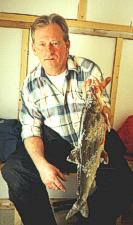Winter Whitefish
© Keith Sarasin 2002
 Whitefish spawn in mid-Nov; along the extensive sand, gravel and stony shoals.
Each female randomly drops from 5-15 thousand eggs before returning to deeper water. The
eggs hatch in late winter and the young fish form schools that travel the shoal areas in
search of food. Whitefish spawn in mid-Nov; along the extensive sand, gravel and stony shoals.
Each female randomly drops from 5-15 thousand eggs before returning to deeper water. The
eggs hatch in late winter and the young fish form schools that travel the shoal areas in
search of food.
The whitefish move into the shoals in advance of the spawning season in Nov. After
spawning they may be found at depths from around 10 to 100 ft, although the largest
numbers are caught at depths of 45-85 ft.
Whitefish feed on mollusks, aquatic insect larvae and nymphs, mostly chironomids,
mayflies and caddisflies. Other items include plankton, crustaceans, terrestrial insects
and small baitfish such as emerald shiners.
Angling for Whitefish
Most common methods used for taking whitefish are live minnows on a tip-up,
fished on bottom. Wax worms often work as well as small night crawlers with a little
bit of air injected to keep them about ¼ inch off bottom.
Look for mossy bottom structure as this holds most of the whitefish's food chain. The
edge of moss beds is another good place to fish, as this bottom will allow the chum you
use to stand out clearly. Jigging with a small spoon by bouncing it off bottom also
produces; the spoon can be fished as is or tipped with a small minnow or piece of minnow.
Bouncing the spoons off the bottom replicates feeding baitfish, which will trigger the
whitefish to feed.
These methods work best in winter through the ice, but are also used during summer from
the side of an anchored boat. Although salted bait is considered the best, simple cut up
bait can be used to attract and keep fish in the area you are fishing. Boiled rice, canned
corn and certain grains can also be used with success. Always soak or boil rice, barley
etc. so it will not expand in the fish's stomach, causing injury or death. Sago is an
exception to this rule.
After pre baiting the area you wish to fish, it is advisable to mark the spot with a
GPS. If you are baiting through the ice, a marker can be used so you can return to the
exact spot next time out. Be careful not to use a fixed anchor with a marker during the
open water season, as these can cause serious injury to boats and boaters. Sometimes a day
or two is needed after baiting to bring the whities in.
Whitefish are well known for their soft bite, and you should take care not to rip the
hook out of the soft mouth. Try the method below to be sure of hooking them in the
stronger upper lip. These fish are more likely to suck the bait up off the bottom rather
than hit the line like most other fish specie.
If using a spreader on bottom for whitefish, it is essential to hook the live minnows
properly for the best hook-set. To do this be sure to hook the minnow through the section
of body near the tail, With the hook facing the tail. Keep away from vital organs.
This will allow the minnow to swim naturally and also keep it alive for a longer period of
time. (See diagram).
By placing the hook so that it faces back towards the tail, the whitefish can take the
bait easily and when you notice the bite you will set the hook into the stronger part of
the upper mouth. Cisco have a thin black upper lip, whitefish have a larger, white upper
lip that is stronger and more gristle like. Worms or wax worms on the other hand, should
be left trailing off the hook slightly.
Spoons
Williams Whitefish Junior, Williams Whitefish Midget, Little Cleo, Mr.
Champ, Luhjohn. Swedish Pimple.
These can be fished as is or tipped with a minnow piece. Usually the head or tail section.
The tail seems to be the most effective on average. The rest of the minnow can be dropped
down the hole as an attractant.
Small spoons should be jigged slowly, letting the spoon touch bottom on the drop. Just
enough to rile the bottom slightly. This represents feeding mollusks etc., and will bring
the whitefish in to feed on them. In turn this will attract them to the spoon.
Six to eight pound test line will give the spoons plenty of action and will be strong
enough to pull a whitefish from the depths. Although they may not be the scrappiest fish
to land, they can be a challenge.
Sometimes they will swim upwards quite fast to cause a slack line and will spit the
hook if you allow them to do this. Always keep tension on the line. If it goes slack, pull
faster to catch up with them and keep the tension on! |